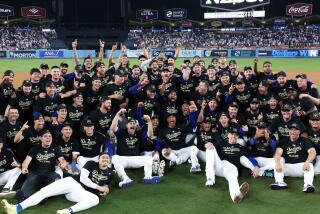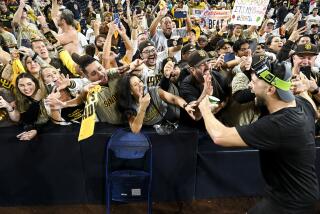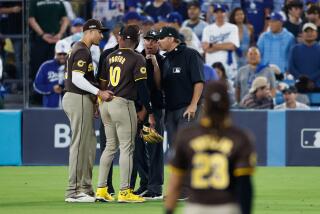New San Diego Ballpark Will Be Fans Dream Come True
San Diego sits at the epicenter of baseballâs millennium tremors. I choose these words knowing itâs a tad insensitive to whisper âEARTHQUAKEâ in a city built atop a fault line and 11 feet above the Pacific Ocean, into which all might come tumbling down, ker-splash.
But the analogy is so apt as to defeat an ink-stained wretchâs feeble attempts at good manners. Besides, while I visit with the Padres president in the teamâs shiny offices, not once does the mirror-walled tower quiver, not even when Larry Lucchino speaks forcefully of the fox that baseball has invited into the henhouse. Speaking here of Rupert Murdoch, the mightiest of moguls, owner of oceans and the sky, his latest bauble being the Dodgers.
âWeâre a microcosm of baseball today,â Lucchino says, ignoring, as San Diegans must, earthquake talk. âWeâve got a new ballpark for 2002. Weâre internationalizing the game by opening in Mexico this season. Weâre a leading advocate of economic restructuring. And weâre a small-market team fighting a war with a large-market team, which we lovingly refer to as âthe monster to the north,â the Dodgers.â
The Murdochian monster sucks money from every corner of the globe. Some $105 million of it made winter miserable in San Diego. The loot bought Kevin Brown away from the Padres, whose offer of $60 million to their surly ace pitcher amounted to throwing spitballs at a battleship.
Lucchino still is distressed. The Padres wanted to keep the pitcher whose work helped them into the World Series and may have gained them goodwill that translated into voter approval of a new ballpark. They offered Brown the richest contract in Padres history.
Worse, Lucchino believes the $105 million deal proves that baseballâs economics are so far out of whack that the industry might collapse under the weight of financial burdens few owners could long carry. He wants evolution toward an owner/player partnership in controlling payrolls. Failing that, he foresees a competitive distortion that would leave even âthe obscenely well-paidâ players frustrated because they also are âintensely competitiveâ and surely will grow restive in a system that denies them a chance to win big.
âThe Dodgersâ payroll this year will be $10-20 million more than the Padresâ gross revenues,â says Lucchino, a man discomfited by that truth as well as by the ominous symbolism of a $100 million player.
âSome franchises arenât worth $100 million,â he says. And this is a 33-year-old pitcher demanding a seven-year deal, $15 million per. âThe bizarre--is that the word, âbizarreâ?--letâs say the unusual perks, the private jets, the going home from the team, all that bothered me.â
Youâd think a man making $300,000 a week could buy his own airplane ticket. Youâd think he could pony up for his own hotel suite. A fan would hate to think heâs coughing up $4 for an ugly hot dog just so Kevin Brown can get double chocolate mints on his pillow, free.
More power to the Padres, then, for drawing a line, even if that line came at an obscene $60 million.
Along with that decision to maintain a semblance of sanity, the Padres have won me over by designing a ballpark that is pure California dreaming.
Itâs to be downtown, displacing the late-20th century decay found at every city centerâs fringe. The plan approved by voters will pay for the ballpark through a $300 million panoply of urban fixtures such as hotels, bars, restaurants, offices and retail shops.
Not Camden Yards, not Jacobs Field, not Coors Field--and certainly not a stadium with a stadiumâs blank stare--the San Diego ballpark will be a new paradigm: a baseball garden, palm trees everywhere, even in a center field park. Yes, a literal park inside the ballpark. The idea came to Lucchino in Yokohama, Japan, when he saw a city park across the street from the ballpark.
âIt was like a carnival,â he says, âwith a Ferris wheel, people walking with their families. And I thought, âItâd be nice to have that feel inside the ballpark.â â
Since buying the Padres after the â94 season, Lucchino and Owner John Moores have done a wonder. They revived a franchise that had become the moribund victim of mismanagement. Their first act was a trade for stars Ken Caminiti and Steve Finley. Only later did Moores and Lucchino introduce themselves at a news conference.
Now all they have to do is do better. Theyâve lost Brown, Caminiti and Finley to free agency. Bad enough, that. The real flak came when the Padres traded 50-home run slugger Greg Vaughn. Suddenly, deep thinkers with access to newsprint and air time noticed a trend.
âSome national media have made us into this yearâs Marlins,â Lucchino says. He referred to Floridaâs 1997 world champions, dismantled on orders from an owner fed up with spending money. âThatâs a misperception. Our payroll budget is up from $44 million last year to $45 million. Thereâs a real sadness at the changing of the guard, but thatâs different from the Marlins, a team that lost its will to win. We are committed to succeeding.â
Lucchino says the trade of Vaughn for the Redsâ Reggie Sanders was as traditional a trade as now can be made. If Vaughn had another big year, the Padres likely couldnât have re-signed him for 2000. Besides, Lucchino says his baseball decision-makers believed Vaughn will not repeat the big year; they further believe that a healthy Sanders is the better player in any case.
Oh, and Larry Lucchino has come up with a way to raise Padresâ revenues. Itâs an office rule. In references to the new ballpark, anyone heard calling it a stadium has to pay up. âThe S-word,â the smiling president says, âis a $5 fine.â
More to Read
Go beyond the scoreboard
Get the latest on L.A.'s teams in the daily Sports Report newsletter.
You may occasionally receive promotional content from the Los Angeles Times.










